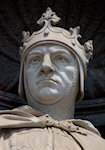Fine Coins Showcase
Antiquities Showcase
Hide empty categories
Shop Search
Shopping Cart
My FORVM
Contact Us
About Forum
Shopping at Forum
Our Guarantee
Payment Options
Shipping Options & Fees
Privacy & Security
Forum Staff
Selling Your Coins
Identifying Your Coin
FAQs
zoom.asp
Home ▸ Catalog ▸ |Featured Collections| ▸ |Sold Collections| ▸ |Louis G Estate Collection||View Options:   | | | | | | |


CR88490. Billon denier tournois, Malloy CCS p. 365, 29; Metcalf Crusades pl. 40, 993; Schlumberger XII 23, aVF, excellent centering, coppery spots, strike a little soft, tiny edge chip, weight 0.640 g, maximum diameter 19.2 mm, die axis 135o, Clarentza mint, 5 Jul - 2 Aug 1316; obverse + LODOVIC'•D'•B'•P•AChE, cross pattée; reverse (annulet) DE CLARENCIA (annulet), castle tournois, surmounted by cross, annulet left of castle; from the Louis G Estate; very rare; SOLD
Crusaders, Frankish Greece, Principality of Achaea, Ferdinand of Majorca, Pretender, Jun 1315 - 5 July 1316


CR88491. Billon denier tournois, Malloy CCS p. 366, 31a; Metcalf Crusades 987 - 992, VF, well centered, clashed dies, weak strike, part of edge ragged, weight 0.684 g, maximum diameter 20.0 mm, die axis 270o, Clarentza mint, pretender, Jun 1315 - 5 July 1316; obverse +•IFANS•F•D'•MAIORK•, cross pattée; reverse (annulet) DE CLARENCIA (annulet), castle tournois, surmounted by cross, surmounted by cross, annulet left and right of the castle; from the Louis G Estate; extremely rare; SOLD
Crusaders, Frankish Greece, Principality of Achaea, Charles II of Anjou, 1285 - 1289


CR88454. Billon denier tournois, Malloy CCS p. 360, 12 (S); Metcalf Crusades pl. 39, 942; Tzamalis Frankish KA101; Schlumberger XII 17, VF, toned, light marks, weight 0.974 g, maximum diameter 18.6 mm, die axis 90o, Clarentza mint, 1281 - 1289; obverse + • K• R• PRINC ACh• (curly foot R = Clarentza mint), cross pattée within inner border; reverse :DE: CLARENCIA: (colons indicate double x stops, DE probably abbreviates denarius, curly foot R = Clarentza mint), castle tournois surmounted by cross dividing legend; from the Louis G Estate; scarce; SOLD
Crusaders, Frankish Greece, Duchy of Athens, William or Minority of Guy I de La Roche, 1280 - 1294


CR88467. Billon denier tournois, Metcalf Crusades pl. 41, 1030; Malloy CCS p. 386, 85, VF, toned, clashed dies, weight 0.756 g, maximum diameter 18.8 mm, die axis 105o, Thebes mint, perhaps minority of Guy I de La Roch, 1280 - 1294; obverse +:G:DVX:ATENES: (: = double trefoil stop, trefoils resembling Y), cross pattée; reverse :ThEBE:CIVIS: (: = double trefoil stop, trefoils resembling Y), castle tournois with open corner circles, surmounted by cross, distinctive style; from the Louis G Estate; SOLD
Crusaders, Frankish Greece, Principality of Achaea, William of Villehardouin, 1246 - 1278


CR88481. Billon denier tournois, Metcalf Crusades pl. 39, 940; Malloy CCS 10a; Tzamalis Frankish GV224; Schlumberger pl. XII, 12, VF, centered, toned, weight 0.822 g, maximum diameter 19.5 mm, die axis 180o, Corinth mint, 1246 - 1278; obverse +:G:PRINCE ACh', cross pattée within inner border; reverse DCLARENTIAV, castle tournois, spire in the form of Λ, surmounted by cross dividing legend; from the Louis G Estate; SOLD
Crusaders, Frankish Greece, Principality of Achaea, William of Villehardouin, 1246 - 1278


CR88482. Billon denier tournois, Tzamalis Frankish GV222; Metcalf Crusades pl. 39, 938; Malloy CCS 10b, aVF, well centered, toned, weight 0.660 g, maximum diameter 19.0 mm, die axis 270o, Clarentza mint, 1246 - 1278; obverse +•G•PRINCEPS, cross pattée; reverse :CLARENCIA▼, castle tournois, spire in the form of Λ, surmounted by cross dividing legend; from the Louis G Estate; SOLD
Crusaders, Frankish Greece, Principality of Achaea, Charles I of Anjou, 1278 - 1285


CR96935. Billon denier tournois, Metcalf Crusades pl. 39, 948; Tzamalis Frankish KA202; Malloy CCS 11 (S), aVF, well centered, light deposits and marks, small edge splits/cracks, weight 0.550 g, maximum diameter 18.6 mm, die axis 0o, Corinth mint, 1278 - 1285; obverse +•K• R• PRINC' ACH' (R with wedge shaped foot = Corinth mint), cross pattée within inner border; reverse ▼CLARENCIA• (R with wedge shaped foot = Corinth mint), castle tournois surmounted by cross dividing legend; from the Louis G Estate; SOLD
Crusaders, Frankish Greece, Duchy of Athens, William or Minority of Guy I de La Roche, 1280 - 1294


CR88466. Billon denier tournois, Metcalf Crusades A7, pl. 41, 1056; Malloy CCS p. 387, 89c var. (stops), VF, centered, toned, clashed dies, reverse double struck, some porosity, weight 0.794 g, maximum diameter 19.00 mm, die axis 225o, Thebes mint, perhaps minority of Guy I de La Roch, 1280 - 1294; obverse +:G•DVX*ATENES: (: = double annulet, * = rosette, angular letters), cross pattée within inner border; reverse :ThEBE*CIVIS: (: = double annulet, * = rosette, angular letters), castle tournois surmounted by cross dividing legend; from the Louis G Estate; SOLD
Crusaders, Frankish Greece, Principality of Achaea, Philip I of Taranto, 1307 - 1313


CR88487. Billon denier tournois, Metcalf Crusades PT3, pl. 40, 984; Malloy CCS 28, VF, well centered, toned, clashed dies, light deposits, weight 0.834 g, maximum diameter 18.7 mm, die axis 135o, Clarentza mint, 1307 - 1313; obverse + Ph'S P ACh' TAR'•⚜• (angular C, R with curly foot = Clarentza), cross pattée; reverse DE CLARENCIA• (angular C, and E, R with curly foot = Clarentza), castle tournois, surmounted by cross, E on each side of castle; from the Louis G Estate; SOLD
Crusaders, Frankish Greece, Principality of Achaea, Florent of Hainaut, 1289 - 1297


CR88457. Billon denier tournois, Malloy CCS p. 361, 13c; Metcalf Crusades type F4, pl. 39, 961, VF, well centered, toned, weight 0.785 g, maximum diameter 19.7 mm, die axis 0o, Clarentza mint, 1289 - 1297; obverse + ⚜FLORENS P AchB, cross pattée within inner border; reverse DE CLARENCIA', castle tournois surmounted by cross dividing legend; from the Louis G Estate; SOLD

You are viewing a SOLD items page.
Click here to return to the page with AVAILABLE items.
The sale price for a sold item is the private information of the buyer and will not be provided.
REFERENCES|
Page created in 1.406 seconds.









